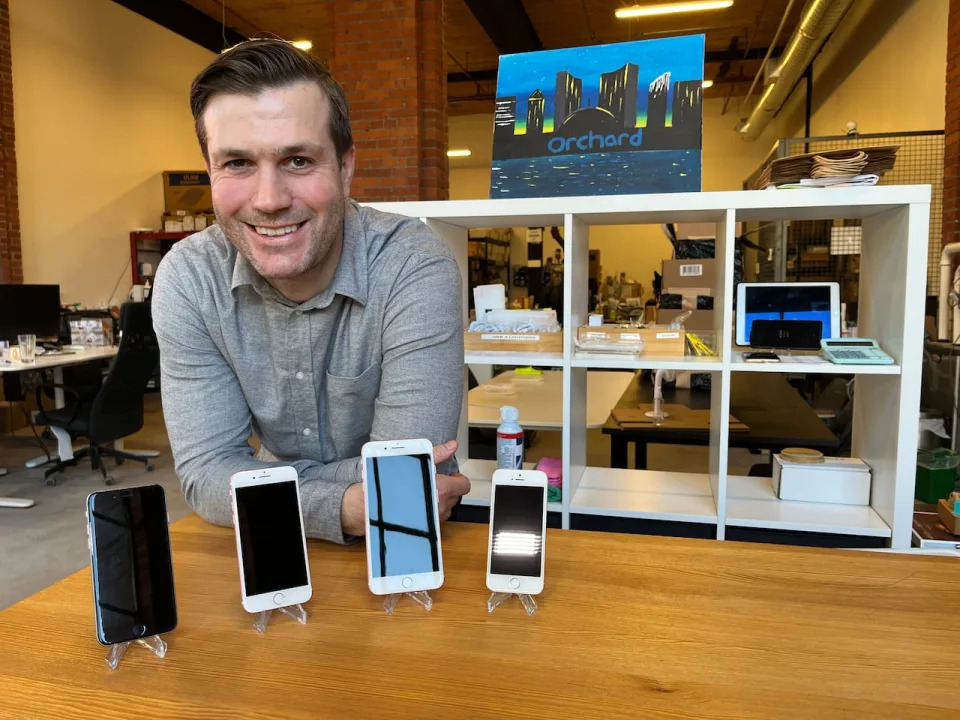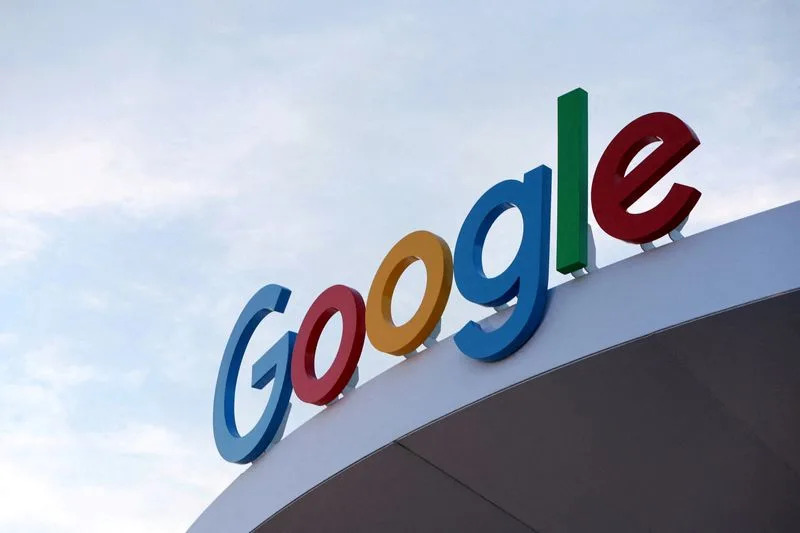Corina Knoll
Updated Sun, March 3, 2024

The heavily-graffiti’d upper floors of Oceanwide Plaza, a trio of skyscrapers in downtown Los Angeles that have sat in limbo for 5 years, plagued by financial and legal issues, on Feb. 9, 2024.
(Hunter Kerhart/The New York Times)
LOS ANGELES — It was a billion-dollar aspiration meant to transform a neighborhood.
A trio of shimmering skyscrapers would feature luxury condos, a five-star hotel and an open-air galleria with retailers and restaurants. Among the amenities: private screening rooms, a 2-acre park, pet grooming services and a rooftop pool. A celebrity fitness trainer would help curate a wellness lifestyle for residents.
The vision was called Oceanwide Plaza, and the CEO said it would “redefine the Los Angeles skyline.” An executive for the design firm said it would create “a vibrant streetscape.” The website said it would be a place of “rare and unexpected moments.”
Sign up for The Morning newsletter from the New York Times
All these statements, some would say, proved to be true. Just not in the way originally imagined.
Funding for the venture quickly evaporated. The towers went up but were unfinished and empty. Plagued by financial and legal issues, the plaza was in a quiet limbo for five years.
Until, recently, an underground community pulled it into an unforeseen spotlight.
Now, those skyscrapers have become a symbol of street swagger, “bombed” with the work of dozens of graffiti writers and artists. Their aliases cover windows that rise more than 40 stories, visible from the nearby highways.
“Everybody’s talking about it, of course,” said Ceet Fouad, a French graffiti artist based in Hong Kong, known for his commissioned murals featuring cartoon chickens. “We said it’s amazing what’s happened — we dream to have a place like this. In the middle of Los Angeles? It’s the best promotion you can have.”
The sentiment is obviously not universal. Many Angelenos see the graffiti as unconscionable vandalism, encouraging waves of crime. Those who live near it say it has jarred their sense of safety. Civic leaders see it as an immediate hazard to the neighborhood as well as to trespassers, not to mention a worldwide embarrassment.
Others have admired the work, some traveling to see the embellished towers for themselves and ruminate on what they represent. Maybe it is the irony of a city desperate for housing. Or maybe it is a statement about greed and wasted opulence. Perhaps emblematic of a Los Angeles spiraling into chaos.
Most would agree that the takeover was cunningly bold.
Vandalism and trespassing had occurred at the plaza over the past few years, city leaders say. But things quickly escalated in late January. New graffiti appeared, and a subculture took note that no one was bothering to clean off the fresh paint.
“It’s pretty unheard-of to paint a skyscraper, so it was like, ‘Oh, man, let’s go take advantage of this and do it while it lasts,’” said Misteralek, one of five graffiti artists who described the scene inside the towers to The New York Times. They spoke on the condition that only their artist names be used because their activities were illegal.
Misteralek managed to get inside with the early wave. It took him about 40 minutes to leave his alias in red and silver.
“We were so happy to be there because I was like, ‘Tomorrow, they’re going to barricade the whole thing.’ But then people just kept doing it.”
Social media posts heightened the buzz. Few knew anything about the history of the towers. But getting into the place seemed strangely simple.
Crews were trudging up together, their backpacks rattling with spray paint. Some lugged up gallons of paint and roller brushes. Security guards on patrol were easy to evade.
Inside, they saw loose wires dangling from ceilings and rebar left exposed. Ladders and buckets littered the concrete floors. Bathtubs were full of rainwater.
“We got a little lost at first; it’s kind of like entering a little city,” said a graffiti artist who goes by Aker and managed to paint his alias twice. Although advice was passed around (bring water, the flight up is killer), he said there was no coordination among artists, just individual ambition.
“You either get in or you don’t,” Aker said, “and you don’t want to miss your chance.”
The names of artists and crews proliferated, the morning sun revealing new additions each day.
Comparisons were made to a former health care building that was “bombed” in December by graffiti artists in town for Art Basel in Miami Beach. But that was much smaller and reportedly slated for demolition.
There was far more global attention paid to the skyscrapers in Los Angeles, with news helicopters and drones broadcasting the staggering monuments of color.
It helped that the plaza was in prime territory — across the street from Crypto.com Arena, the home of the Lakers and the Clippers and the site of this year’s Grammy Awards.
A commercial district with a metro rail station, the area features upscale high-rises, an entertainment complex, a convention center and restaurants. On game nights, cars flood the parking lots and street vendors hawk bacon-wrapped hot dogs.
It is not unusual to see graffiti here as well as giant murals painted on the side of buildings — including one of Clippers forward Kawhi Leonard by street artist Mr. Brainwash. The painted skyscrapers have upstaged it all.
“The biggest conversation is that this has raised the bar — now you gotta do a whole building,” said Robert Provenzano, known as CES, an established graffiti artist from New York City.
CES was commissioned to do a digital art piece for the outside of the Sphere in Las Vegas that was displayed during the week of the Super Bowl. “I thought I was making some moves, but this eclipses that,” he said.
The plaza soon became an illicit playground for people to take photos, light campfires or paint the inside walls.
An Instagram video showed steaks frying on a portable stove inside the towers. Neighbors reported trucks ramming into the gates while thieves made off with copper wire. T-shirts with photos of the plaza sold out online.
Over the weeks, more than a couple dozen people were arrested on suspicion of trespassing. Four of those people were charged, according to the office of the Los Angeles city attorney.
“This is the problem of the city, people do whatever they want,” said Rodel Corletto, who built Aladdin Coffee Shop on a nearby corner four decades ago.
Corletto, 76, said that over the past 15 years, his windows have been broken, his chairs thrown into the street. He often feels like there is no recourse. The plaza, he said, was a larger example of downtown’s lawlessness.
For years, the gleaming yet incomplete towers were considered a business deal gone bust, something for the financiers and the lawyers to figure out while pedestrians wondered whether anything would come of the buildings.
By the time BASE jumpers managed to leap from the towers in mid-February, city leaders were scrambling to figure out their role in a private property gone wrong. They had a responsibility, they said, to keep people safe and set an ultimatum: The plaza owner, Oceanwide Holdings, a conglomerate headquartered in Beijing, was ordered to secure the property within a matter of days.
Messages to Oceanwide went unanswered, and the deadline passed without any action. Around that time, five companies that said they were collectively owed $4.3 million filed a petition to force Oceanwide into bankruptcy. The company has a history of troubled developments, including in New York City and San Francisco. It has been named in numerous lawsuits, including one involving a California construction company that said it is owed nearly $6 million. Oceanwide did not respond to a request for comment.
“For them to have just completely abandoned these properties speaks more volumes about their irresponsibleness as opposed to the graffiti artists,” said Kevin de León, the council member who represents the area.
The city earmarked $1.1 million to start to secure the property, including fencing. De León also said city leaders were looking into estimates for graffiti removal and putting a lien on the property.
“The taxpayers will be repaid,” de León insisted. He said his office has been furiously searching for investors and surmised it would take about $500 million to buy the plaza, along with settling other debts, and another $1 billion to finish it.
Some residents have openly wondered whether the funds might be better used to house the homeless. Or whether the trespassing will be curbed completely. On Wednesday, days after the city began work on the property, authorities announced two additional people had been arrested that morning.
Whatever happens, graffiti artists like Aker say the takeover magnified and transformed a company’s folly hiding in plain sight.
“They failed not just themselves but the city,” he said. “And this is what happens when things just get left — graffiti artists are like spiders. We’ll go out and put webs up there.”
c.2024 The New York Times Company
LOS ANGELES — It was a billion-dollar aspiration meant to transform a neighborhood.
A trio of shimmering skyscrapers would feature luxury condos, a five-star hotel and an open-air galleria with retailers and restaurants. Among the amenities: private screening rooms, a 2-acre park, pet grooming services and a rooftop pool. A celebrity fitness trainer would help curate a wellness lifestyle for residents.
The vision was called Oceanwide Plaza, and the CEO said it would “redefine the Los Angeles skyline.” An executive for the design firm said it would create “a vibrant streetscape.” The website said it would be a place of “rare and unexpected moments.”
Sign up for The Morning newsletter from the New York Times
All these statements, some would say, proved to be true. Just not in the way originally imagined.
Funding for the venture quickly evaporated. The towers went up but were unfinished and empty. Plagued by financial and legal issues, the plaza was in a quiet limbo for five years.
Until, recently, an underground community pulled it into an unforeseen spotlight.
Now, those skyscrapers have become a symbol of street swagger, “bombed” with the work of dozens of graffiti writers and artists. Their aliases cover windows that rise more than 40 stories, visible from the nearby highways.
“Everybody’s talking about it, of course,” said Ceet Fouad, a French graffiti artist based in Hong Kong, known for his commissioned murals featuring cartoon chickens. “We said it’s amazing what’s happened — we dream to have a place like this. In the middle of Los Angeles? It’s the best promotion you can have.”
The sentiment is obviously not universal. Many Angelenos see the graffiti as unconscionable vandalism, encouraging waves of crime. Those who live near it say it has jarred their sense of safety. Civic leaders see it as an immediate hazard to the neighborhood as well as to trespassers, not to mention a worldwide embarrassment.
Others have admired the work, some traveling to see the embellished towers for themselves and ruminate on what they represent. Maybe it is the irony of a city desperate for housing. Or maybe it is a statement about greed and wasted opulence. Perhaps emblematic of a Los Angeles spiraling into chaos.
Most would agree that the takeover was cunningly bold.
Vandalism and trespassing had occurred at the plaza over the past few years, city leaders say. But things quickly escalated in late January. New graffiti appeared, and a subculture took note that no one was bothering to clean off the fresh paint.
“It’s pretty unheard-of to paint a skyscraper, so it was like, ‘Oh, man, let’s go take advantage of this and do it while it lasts,’” said Misteralek, one of five graffiti artists who described the scene inside the towers to The New York Times. They spoke on the condition that only their artist names be used because their activities were illegal.
Misteralek managed to get inside with the early wave. It took him about 40 minutes to leave his alias in red and silver.
“We were so happy to be there because I was like, ‘Tomorrow, they’re going to barricade the whole thing.’ But then people just kept doing it.”
Social media posts heightened the buzz. Few knew anything about the history of the towers. But getting into the place seemed strangely simple.
Crews were trudging up together, their backpacks rattling with spray paint. Some lugged up gallons of paint and roller brushes. Security guards on patrol were easy to evade.
Inside, they saw loose wires dangling from ceilings and rebar left exposed. Ladders and buckets littered the concrete floors. Bathtubs were full of rainwater.
“We got a little lost at first; it’s kind of like entering a little city,” said a graffiti artist who goes by Aker and managed to paint his alias twice. Although advice was passed around (bring water, the flight up is killer), he said there was no coordination among artists, just individual ambition.
“You either get in or you don’t,” Aker said, “and you don’t want to miss your chance.”
The names of artists and crews proliferated, the morning sun revealing new additions each day.
Comparisons were made to a former health care building that was “bombed” in December by graffiti artists in town for Art Basel in Miami Beach. But that was much smaller and reportedly slated for demolition.
There was far more global attention paid to the skyscrapers in Los Angeles, with news helicopters and drones broadcasting the staggering monuments of color.
It helped that the plaza was in prime territory — across the street from Crypto.com Arena, the home of the Lakers and the Clippers and the site of this year’s Grammy Awards.
A commercial district with a metro rail station, the area features upscale high-rises, an entertainment complex, a convention center and restaurants. On game nights, cars flood the parking lots and street vendors hawk bacon-wrapped hot dogs.
It is not unusual to see graffiti here as well as giant murals painted on the side of buildings — including one of Clippers forward Kawhi Leonard by street artist Mr. Brainwash. The painted skyscrapers have upstaged it all.
“The biggest conversation is that this has raised the bar — now you gotta do a whole building,” said Robert Provenzano, known as CES, an established graffiti artist from New York City.
CES was commissioned to do a digital art piece for the outside of the Sphere in Las Vegas that was displayed during the week of the Super Bowl. “I thought I was making some moves, but this eclipses that,” he said.
The plaza soon became an illicit playground for people to take photos, light campfires or paint the inside walls.
An Instagram video showed steaks frying on a portable stove inside the towers. Neighbors reported trucks ramming into the gates while thieves made off with copper wire. T-shirts with photos of the plaza sold out online.
Over the weeks, more than a couple dozen people were arrested on suspicion of trespassing. Four of those people were charged, according to the office of the Los Angeles city attorney.
“This is the problem of the city, people do whatever they want,” said Rodel Corletto, who built Aladdin Coffee Shop on a nearby corner four decades ago.
Corletto, 76, said that over the past 15 years, his windows have been broken, his chairs thrown into the street. He often feels like there is no recourse. The plaza, he said, was a larger example of downtown’s lawlessness.
For years, the gleaming yet incomplete towers were considered a business deal gone bust, something for the financiers and the lawyers to figure out while pedestrians wondered whether anything would come of the buildings.
By the time BASE jumpers managed to leap from the towers in mid-February, city leaders were scrambling to figure out their role in a private property gone wrong. They had a responsibility, they said, to keep people safe and set an ultimatum: The plaza owner, Oceanwide Holdings, a conglomerate headquartered in Beijing, was ordered to secure the property within a matter of days.
Messages to Oceanwide went unanswered, and the deadline passed without any action. Around that time, five companies that said they were collectively owed $4.3 million filed a petition to force Oceanwide into bankruptcy. The company has a history of troubled developments, including in New York City and San Francisco. It has been named in numerous lawsuits, including one involving a California construction company that said it is owed nearly $6 million. Oceanwide did not respond to a request for comment.
“For them to have just completely abandoned these properties speaks more volumes about their irresponsibleness as opposed to the graffiti artists,” said Kevin de León, the council member who represents the area.
The city earmarked $1.1 million to start to secure the property, including fencing. De León also said city leaders were looking into estimates for graffiti removal and putting a lien on the property.
“The taxpayers will be repaid,” de León insisted. He said his office has been furiously searching for investors and surmised it would take about $500 million to buy the plaza, along with settling other debts, and another $1 billion to finish it.
Some residents have openly wondered whether the funds might be better used to house the homeless. Or whether the trespassing will be curbed completely. On Wednesday, days after the city began work on the property, authorities announced two additional people had been arrested that morning.
Whatever happens, graffiti artists like Aker say the takeover magnified and transformed a company’s folly hiding in plain sight.
“They failed not just themselves but the city,” he said. “And this is what happens when things just get left — graffiti artists are like spiders. We’ll go out and put webs up there.”
c.2024 The New York Times Company

















